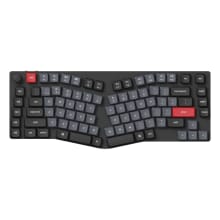Pros
-
Snappy mechanical switches
-
Ergonomic key layout
-
Multiple connection options
Cons
-
Steep learning curve
-
Ineffective backlighting
About the Keychron K15 Pro

The Keychron K15 Pro offers comfortable ergonomics at the cost of a novel layout.
- Price: $94 (white backlight, soldered switches), $114 (RGB backlight and hot-swappable switches)
- Form factor: 75%, 89-key ANSI keyboard layout, Alice Ergonomic
- Connectivity: Detachable USB-C, Bluetooth 5.1
- Dimensions: 14.57 x 5.63 x 1.14 inches
- Weight: 1.53 lbs (696 grams)
- Material: ABS, aluminum frame; PBT keycaps
- Colors: Black
- Switches: Low-profile Gateron (Red/Blue/Brown) mechanical switches
- Special features: Ergonomic design, multi-OS compatibility, tilt legs, VIA compatibility, rotary knob, dedicated macro keys, backlit keys, Windows/Mac keycaps, included keyboard case
The Keychron K15 Pro is a well-built keyboard, offering a thin, aluminum frame with adjustable legs and low-profile, mechanical key switches with shortened keycaps. Our review unit came configured with clicky Gateron Blue switches.
It uses USB-C for wired connectivity and supports Bluetooth 5.1, allowing it to pair with up to three systems and cycle between them with only a few seconds delay. A pair of switches on the back make it easy to go from wired to wireless mode and to flip between Windows/Android and Mac/iOS compatibility modes.
The only big drawback is that Keychron includes backlighting but uses fully opaque keycaps—common across all of their products—so the light spills out between the keys and provides no actual illumination for what’s on each key.
The first thing that’s going to divide a lot of the audience for the Keychron K15 Pro is the big divide tearing right through the middle of the keyboard. It features a split layout that spaces out the keys that are meant for the left hand from those meant for the right. There are a few small exceptions, such as the space bar, which is split into two separate space bars (one for each hand), and the B key, which there are two of so both hands can get at it.

The low-profile keycaps and volume knob being on the lefthand side might not appeal to everyone.
If you’re a meticulous typist who never strays from the path laid out by Mavis Beacon, the split might not throw you for a loop, but if you’re freewheeling and don’t mind occasionally stretching way across the keyboard from time to time, then expect a steepened learning curve.
I tested the Keychron K15 Pro coming fresh off another ergonomic keyboard, the Logitech Wave Keys. While both shift around the angle of the keys to make them ergonomic, Keychron angles the board more extremely than Logitech’s gentle curves. My hands rest quite naturally where they should without noticeable wrist deviation on the keyboard.
This makes typing fairly comfortable, though a palm rest would help.
Typing with the Keychron K15 Pro took some serious adjusting. At first, I was only able to hit around 66 words per minute in the Monkeytype typing test, and that was with a rough 86% accuracy. A few subsequent tests were worse before I got better.
The clicky switches on our review unit have a short travel but excellent precision, and feel splendid (albeit noisy) to tap away at, but they weren’t enough to help me make up for the deficit in typing speed that came from the atypical design.
After a week of using the keyboard regularly, I managed to get a feel for it and raised my typing speed to 104 words per minute with 96% accuracy. With more time spent getting accustomed to the design, I could likely push that higher, but it certainly took a lot of familiarization whereas something like the Logitech Wave Keys had me off to the races in no time.
Should you buy the Keychron K15 Pro?
Maybe, if you’re into the Alice layout

The Keychron K15 Pro keyboard can be configured with low-profile red, blue, or brown mechanical switches.
At $94, the Keychron K15 Pro isn’t absurdly priced for a specialty device. In fact, it’s strikingly reasonable, especially for a keyboard with a snazzy rotary dial that can adjust certain system settings quickly and five dedicated macro keys that live on the left edge of the keyboard. It’s cheaper than our favorite wireless keyboard, Logitech’s MX Keys, and it offers mechanical switches instead of a membrane, but it’s a hard sell for anyone who’s not already set on the Alice keyboard layout.
The Keychron K15 Pro offers comfortable ergonomics with its novel key layout, but you may find some brain discomfort if you can’t get familiar with the shifted and split keys. The lack of a wrist rest also doesn’t lift the ergonomics as high as they could have gone. Keychron’s inclusion of backlighting surely raises the value but is pointless when paired with opaque keycaps. Instead, buying a barebones Epomaker CIDOO ABM066 Alice board for $60 and adding your own switches and keycaps might be a better move if you care about RGB lighting.
Because the Keychron K15 Pro is a niche product that took a considerable lift to even get modestly comfortable on, it’s not easy to recommend outright. But for anyone who’s already on board with a split key arrangement and looking to jump over to the delightful feel of low-profile mechanical switches, the Keychron K15 Pro is a versatile, well-made option.

The Keychron K15 Pro is a low-profile Alice board for ergonomic enthusiasts.
Meet the tester

Mark Knapp
Contributor
Mark Knapp has covered tech for most of the past decade, keeping readers up to speed on the latest developments and going hands-on with everything from phones and computers to e-bikes and drones to separate the marketing from the reality. Catch him on Twitter at @Techn0Mark or on Reviewed, IGN, TechRadar, T3, PCMag, and Business Insider.
Checking our work.
Our team is here to help you buy the best stuff and love what you own. Our writers, editors, and experts obsess over the products we cover to make sure you're confident and satisfied. Have a different opinion about something we recommend? Email us and we'll compare notes.
Shoot us an email


